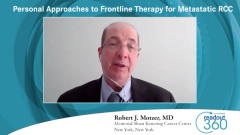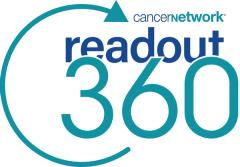
Personal Approaches to Frontline Therapy for Metastatic RCC
Drs Toni Choueiri and Robert J. Motzer discuss factors that impact their decisions for treatment of metastatic renal cell carcinoma in the first-line setting and highlight their go-to regimens.
Episodes in this series

Robert J. Motzer, MD: Until recently, the standard of care for advanced RCC [renal cell carcinoma] consisted of tyrosine kinase inhibitors [TKIs] given as monotherapy. The dominant drugs were sunitinib and pazopanib. More recently it was evident that immunotherapy [IO] was active in RCC, resulting in prolonged survival with nivolumab as a monotherapy, durable responses, and good tolerability. This led to a number of studies that were done in parallel looking at immunotherapy in combination in first-line therapy for renal cell cancer compared to sunitinib monotherapy. The large phase 3 trials were all done in parallel. The regimens were not compared to each other, they were all compared to sunitinib. It makes it difficult to choose one of these drugs or combinations over the other.
The first combination to show a benefit for the intermediate- and poor-risk group was ipilimumab and nivolumab, or IPI/NIVO. That showed a benefit in overall survival [OS] and response rate, primarily in the intermediate- and poor-risk patients. It has the longest duration of follow-up, and it’s become an attractive option for those patients because their responses are sustained. We see about 10% complete responses, and there seems to be a leveling off of progression-free survival without further decline in this important metric. This suggests that response and benefit are sustained for over 4 years now. For the most part, that has been my go-to regimen in first-line therapy for patients who have intermediate- and poor-risk clear cell carcinoma.
More recently there have been 2 randomized phase 3 trials of TKIs plus PD-1 inhibitors, axitinib plus pembrolizumab, and nivolumab plus cabozantinib, that both were compared to sunitinib across the board in all risk groups and showed a benefit in overall survival, response rate, and progression-free survival. These are standouts as options for first-line therapy. Both are FDA approved, and both are now in the NCCN [National Comprehensive Cancer Network] guidelines. They stand above axitinib and avelumab, which didn’t show a survival benefit, because the survival benefit is valued as the gold standard for patient benefit with cancer therapeutics.
It’s difficult to choose one over the other because they haven’t been compared across studies, and either one of them is a good choice. For the most part, they are a good choice for patients who have favorable-risk clear cell carcinoma. They’re also a good choice for patients who have rapidly progressive disease who could run into trouble in a short time, in which you want to guarantee a response. This is because the response rate is so high, about 70%, with these different programs, and also that the response is seen at high levels regardless of risk group. In comparison, the initial response, at least to [ipilimumab, nivolumab], was lower than that of sunitinib in the 214 pivotal trial. Much of it comes down to physician preferences, experience in using these programs, and patient preference in terms of the trade-off for efficacy. There are different toxicity profiles for these different programs and different ways that they’re administered. The risk group can be used to help choose one program after another.
Toni Choueiri, MD: We as investigators are used to presenting the data like they are, and all of these combination treatments occurred at the same time in a way, in the same timeframe. Even if one combination got approved, the trials were still toward the end. What we have is a control arm, which is the same, sunitinib, but none of these combinations were compared against each other. We ended up comparing them in a not-so-scientific, statistically guided way. These were accrued in different years, different timeframe, and their baseline characteristics are different. The performance of the control arm, sunitinib, is different between arms.
Nivolumab and ipilimumab is for intermediate- and poor-risk disease. I don’t use it in favorable risk, knowing that the CR [complete remission] rate is over 10% in favorable risk. If you follow the CR rate as the most important thing, because complete responses tend to be durable, you’re justified to use it. With VEGF/IO, all the approval came in patients with all risk groups: favorable, intermediate, and poor, IMDC [International Metastatic RCC Database Consortium] risk group. On one hand, I follow the evidence of what are the regimens that gave you an overall survival benefit, which remains the gold standard, like it or not, at least when you have it. To that end, you have 3 combinations, 2 with pembrolizumab, which are pembrolizumab/axitinib and pembrolizumab/lenvatinib. The other is nivolumab, VEGF/IO, nivolumab/cabozantinib.
At this time, the pembrolizumab, lenvatinib paper is out, but the regimen is not approved in the US. This makes it a bit easier to compare cabozantinib/nivolumab and axitinib/pembrolizumab. Both do have an OS benefit after more than 1 data update. There are differences between both. Besides the familiarity of the regimen, which investigators, physicians, and health care workers should be familiar with how to use the drug, the baseline characteristics are different.
The cabozantinib plus nivolumab data from CheckMate 9ER had more patients with unfavorable risk categories in terms of the IMDC risk group. They had less favorable and more poor risk than the CLEAR study. They did have more patients without nephrectomy, which the rate of response will decrease with that. They have very strong quality-of-life data. Meanwhile, the CLEAR study was presented, it has the longest progression-free survival and CR to date. More importantly, in that study, it’s hard to put it at the same level yet, because this is the first data cut-off. We did not see quality-of-life data, nor what the OS with hazard ratio is going to be with the next data cut. The most important thing is there are options for patients, and that’s what matters.
Transcript edited for clarity.
Newsletter
Stay up to date on recent advances in the multidisciplinary approach to cancer.



















































































